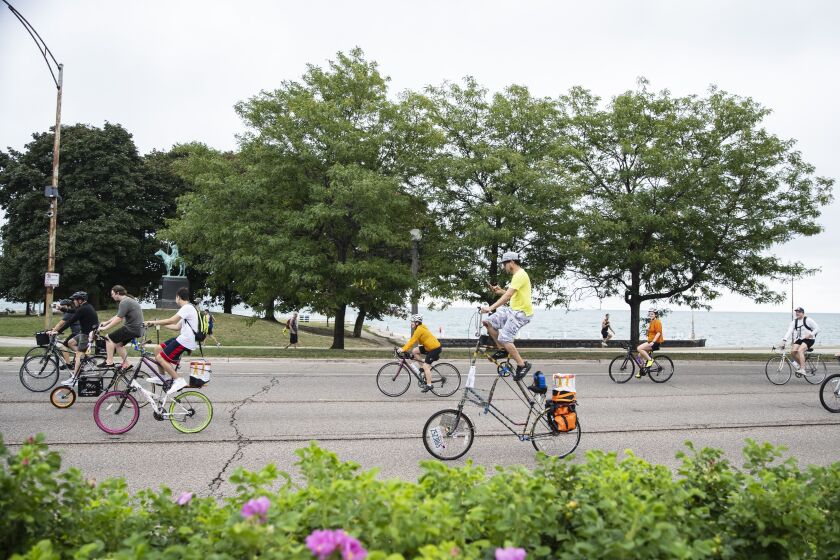Thousands of cyclists — young and old — will take over DuSable Lake Shore Drive Sunday morning during the 22nd annual “Bike the Drive.” For less than six hours, people on bikes get a 30-mile stretch of DuSable Lake Shore Drive all to themselves — unlike the rest of the year when vehicles have full reign there and most everywhere else in Chicago.
Safety on city streets those other 364 days remains a challenge, especially for those traveling by bike. From Jan. 1 through Aug. 26, there were 1,186 traffic crashes involving cyclists — nearly 30% more than during the same period in 2020, according to WBEZ reporter Jessica Alvarado Gamez.
Bicycle injuries have reached epidemic proportions in the city since the start of the pandemic, says Joseph P. Schwieterman, a professor at DePaul University and director of its Chaddick Institute for Metropolitan Development.
Schwieterman notes far fewer people now die in airplane crashes and on factory floors, but “we’ve made little progress” over the decades in lowering bike deaths.
Bike enthusiasts say transit officials need to do more to make Chicago’s streets safer, and we agree. With crashes involving cyclists on the rise and climate change leaving little choice but to find alternatives to fossil-burning cars, it’s time City Hall made upgrading cycling infrastructure a priority.
There’s been some progress. In March, in the final weeks of Mayor Lori Lightfoot’s administration, the Chicago Department of Transportation released a cycling strategic plan .
As Sun-Times reporter Kaitlin Washburn reported last month, the blueprint includes adding 150 miles of new and upgraded bike lanes and creating a continuous grid of low-stress bike routes between neighborhoods.
But we should note that just one-tenth of the city’s more than 4,000 miles of streets are protected bike lanes, neighborhood greenways, off-street trails or other on-street bikeways — not nearly enough to make a major impact.
Mayor Brandon Johnson’s transition team released a report in July outlining policy recommendations for improving safety on the roads for cyclists and pedestrians, which includes lowering speed limits and creating a citywide, protected bike network.
David Smith, the “complete streets” director for the Chicago Department of Transportation, told WBEZ studies have shown the number of people driving over the 30 mph limit on stretches of Augusta Boulevard and Kedzie Avenue went down after protected bike lanes were installed.
Smith said the city plans to narrow travel lanes to reduce driving speeds and repurpose space to better accommodate pedestrians, cyclists and transit users. “The faster that somebody is driving, the more likely that someone who is particularly outside of a vehicle is likely to get seriously injured or killed,” he said.
The good news, Schwieterman tells us, is making streets safer for bicycling “is relatively cheap.” It comes in the form of engineering design like using different elevations, more prominent markings and rubberized poles.
“There’s a lot more that can be done,” he says.
Protecting cyclists on the roads and getting more people on bikes is a win-win for everyone.
The Sun-Times welcomes letters to the editor and op-eds. See our guidelines.





